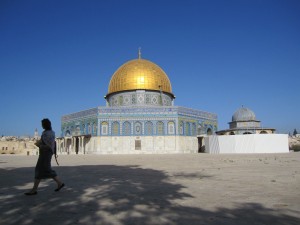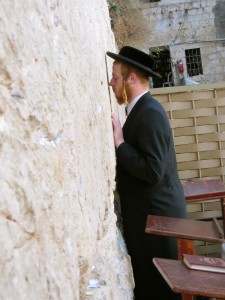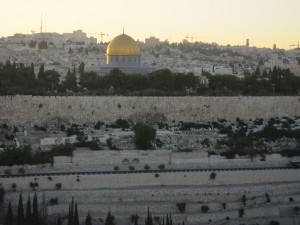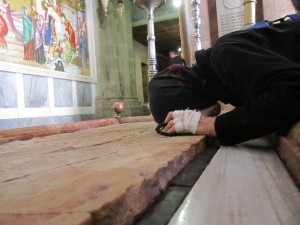
There is something ironic about Old City Jerusalem being called, “The Holy City.” It isn’t.
Jerusalem is a city where stress runs high and the strain of so many people practicing so many religions in such a small area makes the tension palatable. Young Muslim men spitefully mock an elderly Jewish man as he winds his way through the Muslim quarter on his way to morning prayers. Devout Jews press their faces against the Western Wall, crying out to God to hear their prayers while harboring contempt in their hearts toward Muslims whose Dome of the Rock located on the other side of the wall is anathema (it is built on the site where the Jewish temple once stood thousands of years ago). People of traditional religions press their icons and rosaries against the slab of rock within the Church of the Holy Sepulchre believed to be the stone upon which Jesus was laid after being crucified. Tears streaming down their faces, they seek a blessing or a healing or some connection with God through well meaning, but mistaken, devotion.

Bitter schism resides just below the surface and there isn’t any one of these factions that would be disappointed if the other two would exit the city walls. Money is the unifying denominator. Remove the tourist dollar – take away the thousands of global residents who push their way through the throng along the cobblestone streets leaving a significant amount of money with the hundreds of gift shops – and it would boil over.
My task during my eight days of wandering through the Jerusalem maze was to find out what Jerusalem means to the people who live there. Through several interviews and probing questions it quickly became obvious that the romantic notions people I know have of Jerusalem are not shared by the people who live within Old City’s walls. As objective as inhabitants say they are or try to be it all goes pear shaped with one question: What do you think it will take for there to be peace in Jerusalem?
Palestinian Muslims clamor for Jewish building and resettlement to cease in the West Bank and for Jews to reinstate boundary lines as they were in 1948 or 1967. Then, they say, there will be peace. Jews wail at the Western Wall over the defilement they believe the Muslim’s mosque and monument bring to the Temple Mount. Remove the Dome and Mosque and then, they say, there will be peace. Both groups harbor contempt toward “Christians” (the word they associate with those practicing Catholic and Orthodox traditions) for the Crusades and mock them for their idol worship.

I recognize these are generalizations and not everyone in Jerusalem feels this way, but I talked with enough people in each group to get a sense that a significant number of people in Jerusalem believe the most lasting solution for peace rests upon the total expulsion or annihilation of his or her neighbor. As one devout Jew said, “There will never be peace as long as that dome sits on the Temple site.”
The Bible records Jesus approaching Jerusalem from the Mount of Olives and looking across the narrow valley and into the city. The temple would have been plainly visible to Him since its location sat near the wall on that eastern side. His perspective was slightly elevated from the hillside so He was looking down into Jerusalem. “Jesus looked over the city and wept,” Luke wrote of the occasion.
Why was Jesus weeping? Wasn’t Jerusalem a holy city? It was not. It was a religious city – much as it is today – and that is why he wept. The religious leaders of the day brought such bondage on the people that there was no joy in serving and worshiping God. They were so busy ritual keeping that they failed to rightly interpret Scripture and recognize Christ as the fulfillment of thousands of years of prophecy. Jesus wept precisely because there was no holiness, only ritual.

I am convinced after walking the streets myself and talking to devout and secular Jews, Muslims and “Christians” that Jesus would weep because nothing has changed. If anything I’d say it has become more complicated and contentious. The bondage of religion is heavier now than it ever has been. Reconciliation to God through the Son brings peace with God and produces holiness. Holiness before God produces peace within oneself that radiates outward to bring peace among other people. As Paul wrote, “as much as it is within you, live at peace with all men.”
Jerusalem needs your prayers. In fact the Bible commands us to pray for the peace of Jerusalem. Peace will not come through religion, mostly because religion is divisive and some of the great atrocities in the history of the world have come because of religion. Jerusalem is rife with religion.
Don’t call Jerusalem the Holy City. It is not a Holy City; it is a religious city and the difference is the difference between war and peace.
Lee Harrison
Accurate and well stated. Concise and objective. The scriptures and the message of Jesus so eloquently integrated into the article. I saw this on my friends website, http://www.oncedelivered.net.